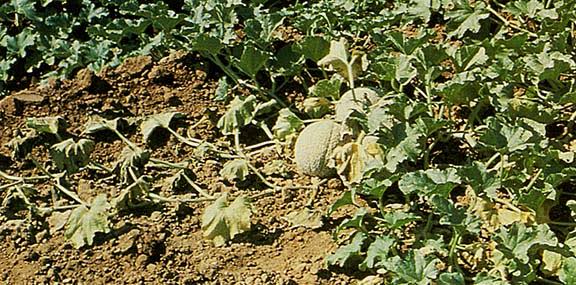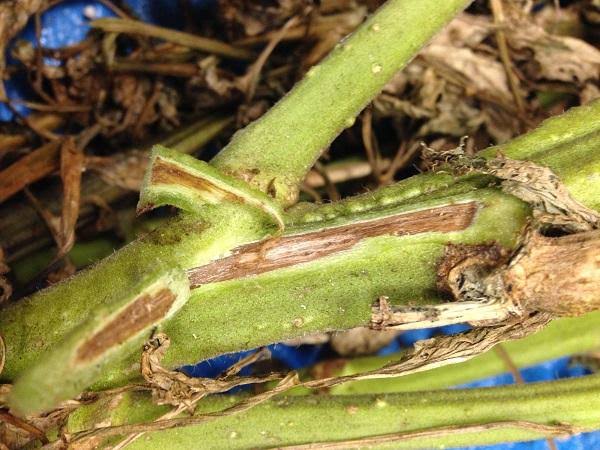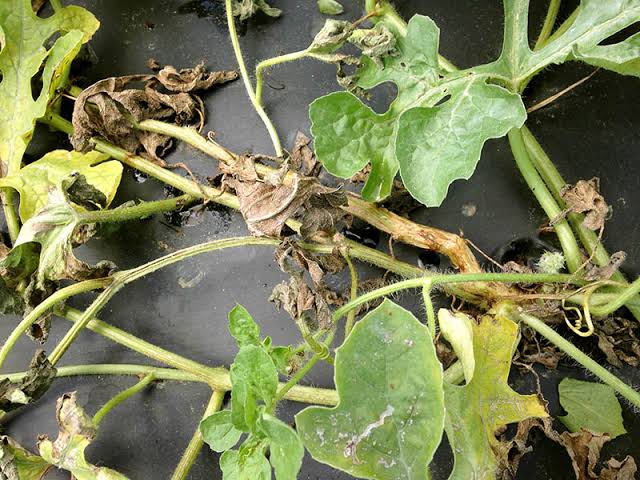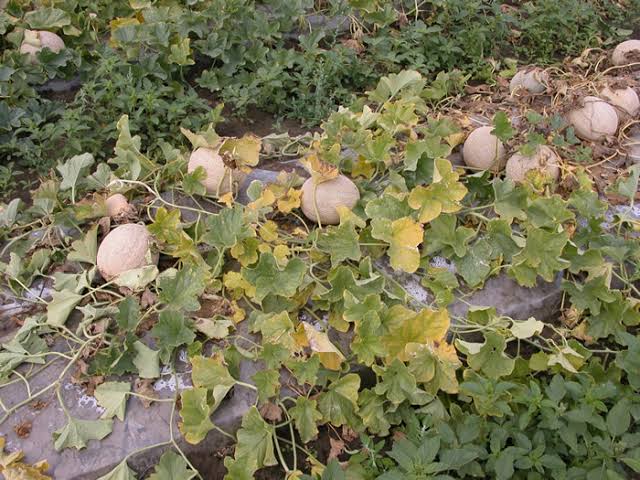Fusarium wilt, scientifically known as Fusarium oxysporum, is a plant disease that causes serious harm to various crops. This troublesome condition is caused by a fungus called Fusarium, and it affects the vascular system of plants, disrupting the flow of water and nutrients. Let’s delve into the intricacies of this agricultural adversary.
At its core, Fusarium wilt starts with the infiltration of the plant’s roots by the Fusarium fungus. Once inside, it swiftly progresses through the vascular tissues, hindering the plant’s ability to transport essential substances. Picture tiny invaders causing chaos within the plant’s intricate plumbing system.
The symptoms of Fusarium wilt are not subtle. Affected plants often display wilting leaves, a sign of their struggle to access water. As the disease advances, the leaves may turn yellow or brown, highlighting the plant’s declining health. It’s akin to a silent invasion, slowly sapping the life out of the unsuspecting host.
One of the challenges with Fusarium wilt is its resilience in the soil. The fungus can persist in the ground for an extended period, waiting for its next victim. Crop rotation and other soil management techniques become crucial strategies in the battle against this persistent foe.
Scientists and farmers alike are tirelessly working to develop resistant plant varieties to combat Fusarium wilt. These efforts involve identifying and cultivating plants with natural defenses against the fungus, providing a sustainable and eco-friendly approach to managing this agricultural menace.
However, prevention remains a key aspect of dealing with Fusarium wilt. Practices such as proper sanitation, using disease-free seeds, and maintaining optimal soil conditions play pivotal roles in keeping this destructive fungus at bay. It’s like implementing a fortress of protection around crops, shielding them from the lurking threat.
Understanding its modus operandi is crucial for developing effective strategies to mitigate its impact. As scientists continue their quest for resilient crops and farmers implement preventive measures, the battle against Fusarium wilt is an ongoing saga in the world of agriculture.
Read Also: 16 Medicinal Health Benefits Of Garcinia pseudoguttifera (Mo’onia Tree)
Plants Affected by Fusarium Wilt (Fusarium oxysporum)

A wide array of plants falls victim to the relentless grip of Fusarium wilt. From fruits and vegetables to ornamental plants, this fungal menace does not discriminate. Common targets include tomatoes, bananas, cucumbers, watermelons, and various other crops that we depend on for sustenance.
Imagine the disappointment as tomatoes, usually vibrant and plump, succumb to Fusarium wilt. The same goes for bananas, an everyday snack for many, as the fungus infiltrates the plants’ vascular system, disrupting the natural flow of nutrients and water.
Ornamental plants, sought after for their beauty in gardens and landscapes, also face the risk of Fusarium wilt. Roses, carnations, and other cherished flowers may wilt and lose their luster, signaling the impact of this insidious fungal infection.
The universality of Fusarium wilt highlights its significance as a threat to global agriculture. Whether it’s the staples on our dinner plates or the flowers that beautify our surroundings, the reach of Fusarium wilt extends far and wide, emphasizing the need for effective measures to protect our plants and crops.
Damages Caused by Fusarium Wilt

The damages wrought by Fusarium wilt are profound and far-reaching, impacting both the quantity and quality of crops. As this fungal foe infiltrates plants, it inflicts a series of detrimental effects, leading to economic losses and challenges for farmers worldwide.
First and foremost, Fusarium wilt disrupts the normal functioning of a plant’s vascular system. This interference hampers the efficient transport of water and nutrients, resulting in wilting, yellowing, and browning of leaves. The compromised vascular system impairs the plant’s ability to thrive, reducing its overall yield.
The economic toll is substantial, as crops affected by Fusarium wilt often suffer significant losses in terms of quantity. A once promising harvest can be diminished, affecting the livelihoods of farmers who rely on these crops for sustenance and income. The financial impact extends beyond individual farmers to the broader agricultural economy.
Moreover, the quality of affected crops is compromised. Fusarium wilt can lead to changes in the texture, taste, and nutritional content of fruits and vegetables. For example, tomatoes may lose their firmness and flavor, diminishing their market value. This not only affects the income of farmers but also has implications for consumers who rely on these crops for a nutritious and varied diet.
The persistence of Fusarium wilt in the soil adds another layer of complexity to the damages. Crop rotation becomes challenging as the fungus lurks in the ground, waiting for the opportunity to strike again. This further exacerbates the long-term consequences of Fusarium wilt on agricultural sustainability.
In essence, Fusarium wilt inflicts a multi-faceted assault on crops, impacting both quantity and quality. The economic and agricultural ramifications of this fungal disease underscore the importance of proactive measures, research, and sustainable farming practices to mitigate the damages and ensure the resilience of global agriculture.
Read Also: 17 Medicinal Health Benefits Of Piper Cubeba (Cubeb Pepper)
Control and Preventive Measures

Controlling and preventing Fusarium wilt requires a multi-faceted approach that combines cultural practices, biological control, and ongoing vigilance. Farmers and researchers employ a range of strategies to safeguard crops from the damaging effects of this persistent fungal disease.
1. Resistant Varieties: Developing and cultivating plant varieties with natural resistance to Fusarium wilt is a cornerstone of prevention. Scientists work to identify and breed crops that exhibit strong defenses against the specific strains of the fungus, providing an inherent barrier against infection.
2. Crop Rotation: Implementing crop rotation is a vital practice to break the life cycle of Fusarium. By alternating different crops in a field, farmers reduce the risk of the fungus building up in the soil. This method disrupts the continuity required for Fusarium wilt to thrive, creating a more hostile environment for the pathogen.
3. Soil Management: Maintaining optimal soil conditions is crucial in preventing the spread of Fusarium wilt. Practices such as proper drainage, avoiding waterlogged conditions, and enhancing soil structure contribute to creating an environment less favorable for the fungus to flourish.
4. Sanitation: Strict sanitation measures help contain the spread of Fusarium wilt. Removing and destroying infected plant residues prevents the fungus from persisting in the soil. This includes prompt removal of infected plants to limit the potential for further contamination.
5. Disease-Free Seeds: Using disease-free seeds is a proactive step in preventing Fusarium wilt. Farmers should source seeds from reputable suppliers and ensure they undergo thorough testing to certify their health. This precautionary measure minimizes the introduction of the fungus into new fields.
6. Biological Controls: Beneficial microorganisms and fungi can be employed as biological controls against Fusarium wilt. These “friendly” organisms can compete with the pathogenic Fusarium, suppressing its growth and reducing its impact on plants.
7. Fungicides: In some cases, the application of fungicides may be considered. However, this approach should be approached cautiously, considering its environmental impact and the potential for developing resistance in the Fusarium population.
However, an integrated and sustainable approach is essential in controlling and preventing Fusarium wilt. By combining resistant plant varieties, effective cultural practices, and biological controls, farmers can fortify their crops against this persistent fungal menace, ensuring the long-term health and productivity of agricultural systems.
Frequently Asked Questions (FAQs) About Fusarium Wilt (Fusarium oxysporum)
1. Q: What is Fusarium wilt?
A: Fusarium wilt is a plant disease caused by the fungus Fusarium oxysporum. It affects various crops by invading their vascular systems, disrupting the transport of water and nutrients.
2. Q: Which plants are commonly affected by Fusarium wilt?
A: Fusarium wilt can impact a wide range of plants, including tomatoes, bananas, cucumbers, watermelons, roses, and other ornamental flowers.
3. Q: How does Fusarium wilt spread?
A: The fungus spreads through contaminated soil, water, and infected plant material. It can persist in the soil for extended periods, making prevention and control challenging.
4. Q: What are the symptoms of Fusarium wilt?
A: Symptoms include wilting, yellowing, and browning of leaves. As the disease progresses, affected plants may exhibit stunted growth and reduced yields.
5. Q: Can Fusarium wilt be prevented?
A: Yes, preventive measures include using resistant plant varieties, practicing crop rotation, maintaining proper soil conditions, practicing sanitation, and using disease-free seeds.
6. Q: Are there chemical treatments for Fusarium wilt?
A: Fungicides may be considered in some cases, but their use should be approached cautiously, considering environmental impact and potential resistance development.
7. Q: How long can Fusarium persist in the soil?
A: Fusarium can survive in the soil for an extended period, making crop rotation and soil management crucial in controlling its spread.
8. Q: Can Fusarium wilt be transmitted between different types of plants?
A: Fusarium wilt is often specific to certain plant species or even cultivars within a species. However, some Fusarium strains can affect multiple plant types.
9. Q: What is the economic impact of Fusarium wilt?
A: Fusarium wilt can cause significant economic losses by reducing both the quantity and quality of crops, affecting farmers’ income and the broader agricultural economy.
10. Q: Are there ongoing research efforts to combat Fusarium wilt?
A: Yes, scientists are actively researching and developing strategies, including breeding resistant crops, exploring biological controls, and improving cultural practices, to mitigate the impact of Fusarium wilt on agriculture.
Read Also: Guide to Waste Management Industry Trends

